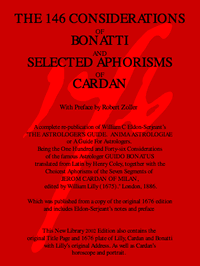Liber Hermetis Part 2 The Book of Hermes Part Two
The Liber Hermetis, the Book of Hermes is considered one of the more important astrological and Hermetic texts. Translated from an ancient Latin manuscript, this is the first English translation (revised and updated) of this remarkable work.
Such distinguished authorities as Festugiere and Pingree point to the Liber Hermetis as containing similarity with ancient Hermetic texts while the great German academic Wilhelm Grundel considered the evidence sufficient to proclaim it as deriving from the Egyptian priest Hermes Trismegistus, incorporating astrology as practiced in the Egyptian temples as early as the beginning of the 2nd century BC.
The original Greek text(s) upon which it is based have vanished. Only a single Latin manuscript survives, lodged with the British Library Codex Harleianus 3731, dated 1431 (though its content and style strongly suggest that it was complied by the 6th or 7th centuries AD). It is that Latin text which has been translated for the first time into English in this work.
The Book of Hermes presents a pre-Christian Era astrology rooted in Hermetic astrology, which was then as now used for achieving knowledge, ultimately of spiritual matters. It is also replete with Hellenistic insight such as Pythagorean numerology and geometry, and the use of planets as ciphers. In tandem with this, it includes references to later authors including Dorotheus, Ptolemy, Valens and Critodemus (all 1st & 2nd century AD) incorporating “non-Hermes” doctrine prevalent at the time it was complied.
Published in two volumes, the Book of Hermes Part I presents extensive study and technique on the lots (commonly called the Arabic Parts today); the houses (domus); the nature of the seven ancient planets - singularly, in transit of each other, and in return (or revolution) charts; the use of the decans which become visible in the night sky during their heliacal rising (their images - the decan-star images like the images of the Signs of the constellations so familiar to us today being an essential part of early Western Predictive astrology); the Zodiacal Signs (remembering that there are three zodiacs: the Constellations, the Tropical and the Sidereal which all share the same names but are not to be confused in practical application); and the importance of the correlation between the Sun and Moon (phases of the Moon); matters relating to personal danger; consideration of a person’s death and instruction as to the calculation of the year, month and on what day death will occur; on marriage and intimate partners ; on parents (their profession and social standing, and their deaths); on sexual acts (homosexual and heterosexual), and on other matters relevant to the place and time that it was written such as the disposition of slaves or the quality of foreign or culturally alien people, as then judged.
As in most cases of astrological literature there is a reflection of the paradigms dominating at the time of writing and while these may be anachronistic today the underlying astrology (which always operates independently of local proclivities or prejudices through which it is so often squeezed) remains salient.
Collectively, it provides some of the oldest material we have of horoscopic astrology, which still forms the basis of Western Predictive astrology today. It also comes with a lengthy introduction and copious footnotes to help the modern astrological practitioner and student better understand the text’s meaning and instruction.
The second volume, the Book of Hermes Part II, concentrates on the Fixed Stars and the power of specific degrees; the triplicities; defluxions, conjunctions and the separation of and void-of -course Moon, and on matters of death (including biothanati (violent death)).
This Book of Hermes clearly draws on an originating astrology and may indeed have been derived from the master Egyptian text that Vettius Valens (2nd century AD – a younger contemporary of Ptolemy) and others refer to. We may never know the answer to that but what is clear is that for the Western Predictive astrologer this is a crucial text that provides insights into predictive technique not readily found elsewhere. For those too, who have an enlightened understanding of the Hermetic tradition, and thus who seek practical tools for attaining a knowledge (as opposed to the confounding of faith or belief) of matters spiritual this work will repay careful study. Finally, students of the Diploma course will find it worthwhile reading this work early on in their studies as many of the concepts are expanded in the DMA lessons and precognition will serve you well.
Similar items
Customer Reviews
I would agree with Grundel, much of this work must derive from pre-Christian Egyptian origins. One of the few texts to survive which repays serious study.








